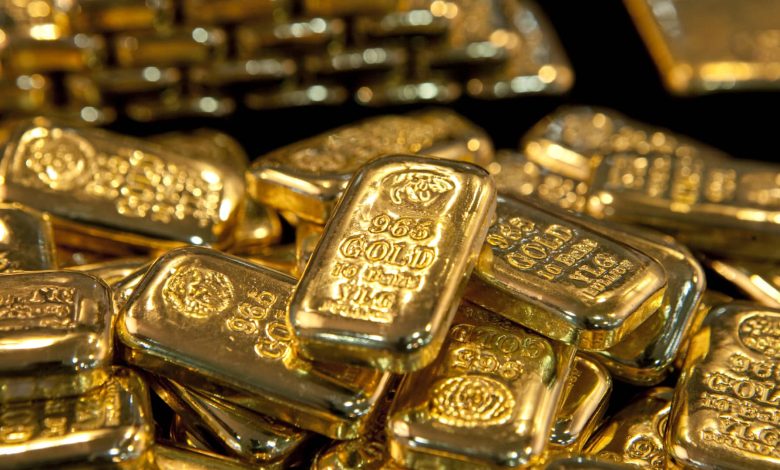Here’s how the pros are investing in the gold rally

U.S. President Donald Trump’s fresh 30% tariffs on the European Union and Mexico have sent gold prices higher. The previous metal topped a three-week high on Monday , as investors piled into gold, which is usually considered a safe haven asset in times of turbulence. As of 10:20 p.m. ET Monday, spot gold was up 0.21% at $3,350.69 per ounce. Mounting geopolitical tensions and uncertainties from Trump’s on-again-off-again tariffs have sent gold prices up by around 28% since the start of the year. By comparison, the broad-based S & P 500 index has risen 6.58% in the same time, while yields on the 10-year U.S. Treasury have moved down 13.4 basis points. “Gold has outperformed the S & P 500 and even other traditional safe haven assets such as U.S. Treasuries, which haven’t necessarily provided that stability because of their volatility and fluctuating yields,” Alonso Munoz, chief investment officer and founding partner at the U.S.-headquartered Hamilton Capital Partners, said. XAU= YTD mountain Mounting geopolitical tensions and uncertainties from Trump’s on-again-off-again tariffs have sent gold prices up by around 28% since the start of the year Speaking to CNBC Pro, Munoz noted a pick-up in investor interest in the precious metal “after they’ve seen gold outperform and act as a hedge, at least certainly during the first and second quarter, where we had a lot of volatility in high-risk assets.” The investor sees scope for gold to continue to push higher this year, “as long as things remain uncertain.” Chee Keong Koh, head of forex strategy at wealth management firm WRISE, said he expects spot gold to hover between $3,100 and $3,500 for the rest of 2025. “Gold’s performance during times of crises, its ability to act as a store of value and its role as an effective diversifier continue to be key reasons for why investors continue to allocate gold as part of risk management and tactical trading strategies, as global reserves increasingly shift away from heavy U.S. dollar reliance over the next five years ,” Koh said, citing findings from a recent survey by the World Gold Council. The council — which represents the gold industry — found that 95% of survey respondents foresee an increase in global central banks’ gold reserves in the next 12 months. Meanwhile, 73% predict significantly lower U.S. dollar holdings within reserves over the next five years. Aside from the de-dollarization push, Stefan Hofer, chief investment strategist APAC at LGT Private Banking Asia, expects gold prices to rise further as the U.S. Federal Reserve is likely to lower interest rates . He foresees gold hitting $3,650 per ounce in the next 12 months, a close to 9% rise from its current levels. “Inflation expectations are going up. People are going to be buying gold against that,” Hofer told CNBC’s Squawk Box Asia on Monday. Hofer dismissed ” outlandish ” calls of gold reaching $5,000 per ounce or more, but said a 10% rise over the next 12 months, “means, that in a portfolio context, you could do rather well if you have maybe, say, 5% or so allocation.” Gold stocks and ETFs WRISE’s Koh recommends that investors who want to buy into gold consider entering closer to the $3,100-per-ounce range “as part of a broader portfolio diversification strategy.” Among his top gold stock picks are mining companies Barrick Gold and Newmont Corporation . Both companies present “solid opportunities given their solid earnings growth and strategic positioning in the gold market,” according to Koh. Beyond stocks, he also sees opportunities in the VanEck Gold Miners ETF and VanEck Junior Gold Miners ETF . The former has returned nearly 55% since the start of the year, while the latter’s returns are over 60%. Physical gold Holding on to physical gold, in the form of gold bars, is another way to invest, Hamilton Capital’s Munoz pointed out. “I’ve always thought that if investors own gold, for its safety and protection against catastrophe and significant drops in the market, they should own it physically versus just tracking the price of gold in a product where there’s counterparty risk,” he said. The investor observes that his clients, who are predominantly high-net-worth individuals and family offices, like that physical gold is a “safe and tangible store of value that tracks the price of gold at a much lower cost.” For instance, an ETF charges investors between 10-40 basis points each year just to own a derivative of gold. So an investor with a 5% allocation to gold by way of an ETF will make a cost saving by owning the physical metal, Munoz said. However, those considering buying physical gold should consider storage costs , he added. Safe haven? While gold is often touted as the classic safe-haven asset, Will McDonough, CEO of merchant bank Corestone Capital, believes it could be losing its edge. He said rival asset classes could include copper, as well as bitcoin, which crossed the $120,000 threshold to hit a record high on Monday . “Gold has far less real-world use cases than copper. And bitcoin is taking a lot of energy away from gold — so the safe-haven allocation that used to go to gold is now facing competition from other assets,” McDonough told CNBC Pro. Still, the investor sees value in gold by way of the physical asset and gold futures.



